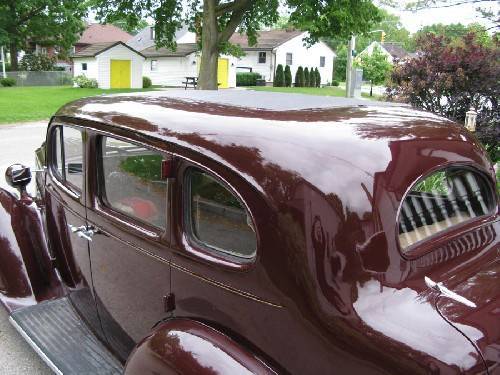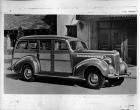|
Re: 1937 roof
|
||||
|---|---|---|---|---|
|
Forum Ambassador

|
No, it did not.
Posted on: 2013/3/7 23:09
|
|||
|
||||
|
Re: 1937 roof
|
||||
|---|---|---|---|---|
|
Webmaster
|
The aluminum was probably done later in it's life when the orignal roof started to leak.
Posted on: 2013/3/8 13:11
|
|||
|
-BigKev
1954 Packard Clipper Deluxe Touring Sedan -> Registry | Project Blog 1937 Packard 115-C Convertible Coupe -> Registry | Project Blog |
||||
|
||||
|
Re: 1937 roof
|
||||
|---|---|---|---|---|
|
Home away from home

|
Interesting discussion and thanks Rusty for laying out the details.
Prior to all steel roofs it seems that Packard and other OEMs were able to construct several roofs and therefore body styles with a comparatively few number of stampings. For example, the shape of the '35-39 Senior club sedan rear roof section appears to be the same as all the touring sedans, which suggests that Packard stamped one rear roof shell with backlight opening then trimmed to get a particular C-pillar shape. Perhaps formal sedan's solid C-pillar may also have come from this same initial stamping. The 5-pass coupe and 2/4 coupe also appear to share a common rear roof shell, narrower than the sedans and differently shaped. Appears that Packard also had two unique stampings for the roof forward section from windshield to B-pillar, one for the short front door and another for the long... or perhaps one common stamping from windshield to leading edge of insert for all body styles and seperate sections above the remaining length of the two front door lengths. Also unique stampings for the roof side sections above the three rear door lengths and for the 5 pass coupe to connect the front to the rear roof sections. Can anyone confirm or clarify any of this? Since we are on the topic of roofs, recall reading that Clipper was first Packard to use a roof stamped in one piece from windshield to end panel/decklid. Have seen pics of late 30s GM roofs being welded together and they appear to have a separate top cap that was welded to the roof C-pillar and backlight panels. Is this how Packard roofs were constructed from '38-42? (excluding Clipper). If so, did the 138" and 148" wheelbase cars have a one piece stamped cap or were they a mod of the 127" roof cap with inserts welded in? Thanks. UPDATE: some of the pics near bottom of link show early 40s or early post-war GM roof stamping and assembly. Appears to be an "almost" one piece roof, the lower part of C-pillar being seperate. The pic I had seen in a book was of an earlier GM car, probably late 30s, with a seperate top cap. Will post if I can find. http://www.coachbuilt.com/bui/f/fisher/fisher.htm
Posted on: 2013/3/17 14:36
|
|||
|
||||
|
Re: 1937 roof
|
||||
|---|---|---|---|---|
|
Forum Ambassador

|
A very exacting duplicate of the original material is available as "colonial long grain" roof topping from either Restoration Specialties or Restoration Supply, that's what I used on my 34 and it was a dead match for the original. As to color, I've heard it debated before but my opinion is that they were originally all black with the possible exception of cars with custom coachwork. But we also know that some folks have subsequently colorized them. Even though the photos are B&W, you might look thru the original Packard factory photos from the Making of Modern Michigan collection to see if you can see any evidence to the contrary.
Posted on: 2013/7/13 14:13
|
|||
|
||||
|
Re: 1937 roof
|
||||
|---|---|---|---|---|
|
Quite a regular

|
The insert on my Maroon 37 - 115C is black and is in wonderful shape.
Bob
Posted on: 2013/7/14 17:34
|
|||
|
1937 Packard Six 115-C Touring Sedan
Built in Windsor, ON Canada |
||||
|
||||
|
Re: 1937 roof
|
||||
|---|---|---|---|---|
|
Home away from home

|
I'm not so sure that stampings is the sole reason. After all, the cowl and rear quarters were separate stampings that were leaded at the seams. There was nothing to stop them from doing the same thing on the roof.
The Pierce Silver Arrow had an all metal roof. If it was stampings not being big enough then I would think that coupes would have started having all steel roofs earlier and progressed by body size. Didn't Jordan offer an all steel body in the 20's?
Posted on: 2013/7/14 18:38
|
|||
|
||||
|
Re: 1937 roof
|
||||
|---|---|---|---|---|
|
Home away from home

|
Mahoning you mention using the same stamping to make 2 different panels by trimming to a different shape. This was done using a "trim die", a small die that cut off the excess material.
An example is the rear doors of 51 up Packard sedans. If you look close, the senior and junior bodies used the same door except the senior door had a smaller cutout for rear fender clearance. This was achieved by making 1 panel and 2 trim dies. Another example was the 1936 - 37 Cord sedan. The front and rear doors were the same, except the rear door stamping was notched for fender clearance using a trim die. This allowed them to make 4 doors with 2 stampings.
Posted on: 2013/8/17 22:23
|
|||
|
||||
|
Re: 1937 roof
|
||||
|---|---|---|---|---|
|
Home away from home

|
What material was used that secured the long-grain to the metal section of the roof? Some sort of lead?
And - most important - where does one purchase it now?
Posted on: 2013/8/19 22:45
|
|||
|
||||
|
Re: 1937 roof
|
||||
|---|---|---|---|---|
|
Home away from home

|
Bump
Posted on: 2013/8/20 13:19
|
|||
|
||||

 (83.23 KB)
(83.23 KB)







